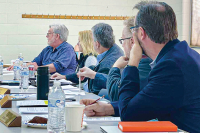Men who built Blue Ridge Parkway recount hard work, dangerous conditions
Lorin Shaw was barely 16 when he landed a job with a crew building the Blue Ridge Parkway in the late-1930s.
“We were lucky to get the work because there was no work back then,” said Shaw, who was born in 1923 in Burnsville.
When Shaw was hauling a load of hot tar one day, the lid came loose on the vat. As he put on the breaks coming down hill into the work site, hot tar oozed over the rim and spilled into the cab of the truck and down his back.
“When I stepped off the truck they cut my shirt and stuff off of me — just as soon as I stepped off. If it had stayed on there, it would have left scars,” Shaw said. “Any time you are messin’ with trucks and equipment in the mountains, you’ve got to watch it. You could get hurt.”
Shaw made $12 a week and did whatever he was told.
“Up on the, Parkway you didn’t say you couldn’t do it cause about 10 more of ‘em were waiting to take your job,” Shaw said. “There wasn’t no jobs.”
Related Items
The Parkway’s construction employed hundreds of local men during the Depression when work was scarce everywhere — but especially in the mountains. Most involved in the early construction have now passed away, but stories like Shaw’s were captured in oral history interviews by the National Park Service.
Ben Caudill, born in Sparta in 1925, had to lie about his age to land a job on the Parkway. Caudill was part of a Civilian Conservation Corps landscaping crew that felled trees by hand with cross-cut saws and axes to make way for the road builders. After construction, the crew went back to replant the denuded roadsides.
In an oral history, Caudill recounted bluntly the fate of a family member employed in a far more dangerous line of work on the Parkway.
“My first cousin got blowed up at Ice Rock,” Caudill said.
The Parkway often came up against sheer, rock cliffs, like the infamous Ice Rock. Blasting was the only way to chisel out a toehold for the road.
“They’d tie you to a rope and tie the dynamite to you and let down the rope, drill your hole and fill it full and bring you back out and then shoot it,” Caudill said.
Dynamite crews made more than any other workers, 65 cents an hour from what Raleigh Hollefield remembers.
“Blastin’ and drillin’ is what I done,” said Hollefield, who was born in 1923 in Little Switzerland. “It was pretty dangerous and a rough job.”
Buren Ballard, born in 1909 in Weaverville, made 45 cents an hour drilling holes for the dynamite — less than the blasters but more than the average laborers.
“We’d go way up above on one of them big cliffs and tie a rope to a tree, and then put on a safety belt, and then go down on that cliff. And they’d swing the jackhammer down to us. I would stay on them cliffs for three and four hours,” Ballard said in an oral history interview on file in Parkway archives.
When building tunnels, Ballard would stand on scaffolding across its face, drilling away with his 60-pound jackhammer.
A man on his crew was killed when he drilled into a hole that was already filled with dynamite that not yet been set off. Another man was loading dynamite into a hole when lightning struck it and blasted apart the rock, breaking the man’s hip.
Ballard worked on the morning shift, which started at 5 a.m. It was too dark to see yet, so he laid a flashlight across the rock when starting a hole. He got up at 2 a.m. and walked out to the main road by his house, where another worker picked him up. If it was too muddy or icy, they both walked through the woods and over mountains for two hours to get to work.
His wife packed him a lunch of biscuits, eggs, ham and jelly — and a thermos of coffee. On the job site, he would cut a limb off a bush and hang his lunch box from the stub.
It was cold work given the Parkway’s high elevation. When Ballard was first hired, his job was to walk up and down an air compressor line that fed the jack hammers, lighting small fires along its one-mile run to keep it from freezing.
Until the Parkway came along, there were no prospects for work.
“Couldn’t find a job nowhere,” Ballard said. “If it hadn’t been for Roosevelt, I guess I’d have starved to death.”
The Parkway was launched under the New Deal, but only a fraction of the labor came from the Civilian Conservation Corps or Works Progress Administration. The bulk was contracted out to construction companies, which in turn hired local men.
Unlike other massive public works during the era, like the building of the Hoover Dam or Golden Gate Bridge, relatively few were injured or killed during Parkway construction, however.
“It was minimal considering the work,” said Harley Jolly, a Parkway historian and author in Mars Hill. “When you look at moving mountains the way they had to move mountains, that was a major challenge. When you blast way the whole side of a mountain it is dangerous.”
The Parkway was known then as “The Scenic,” and is still called that by old-timers who were part of the construction.
“They were proud to be able to have a job,” Jolly said. “The income gave them a better life than they would have had without the Parkway.”
But the work wasn’t for everyone. Homer Reeves, born in 1910 in Sparta, walked off the job after a close encounter with a poisonous snake, a four-foot-long copperhead on the rock where he was working.
“That was the end of my work with the Parkway. I said, ‘I wasn’t gonna mess with any more of that.’ Never did go up any more after that on the Parkway,” Reeves said in an oral history interview in the mid-1990s.
The work was hard, Reeves recounted. The snow was a foot deep his first day of work. When it rained, mud came up to their knees. It would take half a dozen men to free trucks when they got stuck.
“Tires didn’t last no time. You’d hit a rock and bust one. There was just something all the time as far as that goes,” Reeves said. “But it give people a lot of work that’s one thing. The Parkway helped a lot of people.”









